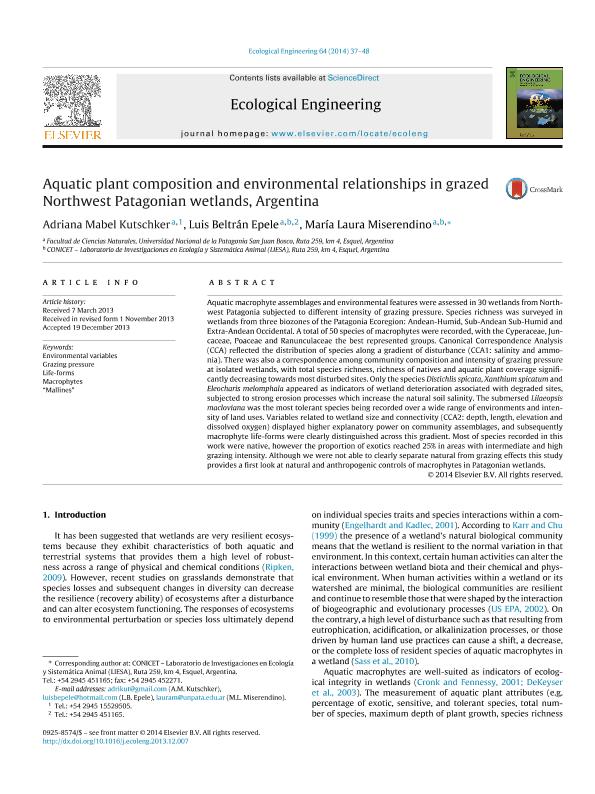Mostrar el registro sencillo del ítem
dc.contributor.author
Kutschker, Adriana Mabel

dc.contributor.author
Epele, Luis Beltran

dc.contributor.author
Miserendino, Maria Laura

dc.date.available
2017-06-19T20:39:12Z
dc.date.issued
2014
dc.identifier.citation
Kutschker, Adriana Mabel; Epele, Luis Beltran; Miserendino, Maria Laura; Aquatic plant composition and environmental relationships in grazed Northwest Patagonian wetlands, Argentina; Elsevier Science Inc; Ecological Engineering; 64; -1-2014; 37-48
dc.identifier.issn
0925-8574
dc.identifier.uri
http://hdl.handle.net/11336/18483
dc.description.abstract
Aquatic macrophyte assemblages and environmental features were assessed in 30 wetlands from North- west Patagonia subjected to different intensity of grazing pressure. Species richness was surveyed in wetlands from three biozones of the Patagonia Ecoregion: Andean-Humid, Sub-Andean Sub-Humid and Extra-Andean Occidental. A total of 50 species of macrophytes were recorded, with the Cyperaceae, Jun- caceae, Poaceae and Ranunculaceae the best represented groups. Canonical Correspondence Analysis (CCA) reflected the distribution of species along a gradient of disturbance (CCA1: salinity and ammo- nia). There was also a correspondence among community composition and intensity of grazing pressure at isolated wetlands, with total species richness, richness of natives and aquatic plant coverage significantly decreasing towards most disturbed sites. Only the species Distichlis spicata, Xanthium spicatum and Eleocharis melomphala appeared as indicators of wetland deterioration associated with degraded sites, subjected to strong erosion processes which increase the natural soil salinity. The submersed Lilaeopsis macloviana was the most tolerant species being recorded over a wide range of environments and inten- sity of land uses. Variables related to wetland size and connectivity (CCA2: depth, length, elevation and dissolved oxygen) displayed higher explanatory power on community assemblages, and subsequently macrophyte life-forms were clearly distinguished across this gradient. Most of species recorded in this work were native, however the proportion of exotics reached 25% in areas with intermediate and high grazing intensity. Although we were not able to clearly separate natural from grazing effects this study provides a first look at natural and anthropogenic controls of macrophytes in Patagonian wetlands.
dc.format
application/pdf
dc.language.iso
eng
dc.publisher
Elsevier Science Inc

dc.rights
info:eu-repo/semantics/openAccess
dc.rights.uri
https://creativecommons.org/licenses/by-nc-sa/2.5/ar/
dc.subject
Environmental Variables
dc.subject
Grazing Pressure
dc.subject
Life-Forms
dc.subject
Macrophytes
dc.subject
Mallines
dc.subject.classification
Ecología

dc.subject.classification
Ciencias Biológicas

dc.subject.classification
CIENCIAS NATURALES Y EXACTAS

dc.title
Aquatic plant composition and environmental relationships in grazed Northwest Patagonian wetlands, Argentina
dc.type
info:eu-repo/semantics/article
dc.type
info:ar-repo/semantics/artículo
dc.type
info:eu-repo/semantics/publishedVersion
dc.date.updated
2016-11-23T19:41:04Z
dc.journal.volume
64
dc.journal.pagination
37-48
dc.journal.pais
Países Bajos

dc.journal.ciudad
Amsterdam
dc.description.fil
Fil: Kutschker, Adriana Mabel. Universidad Nacional de la Patagonia; Argentina
dc.description.fil
Fil: Epele, Luis Beltran. Universidad Nacional de la Patagonia "San Juan Bosco". Facultad de Ciencias Naturales - Sede Esquel. Departamento de Biología. Laboratorio de Investigaciones en Ecología y Sistemática Animal; Argentina. Consejo Nacional de Investigaciones Científicas y Técnicas; Argentina
dc.description.fil
Fil: Miserendino, Maria Laura. Universidad Nacional de la Patagonia "San Juan Bosco". Facultad de Ciencias Naturales - Sede Esquel. Departamento de Biología. Laboratorio de Investigaciones en Ecología y Sistemática Animal; Argentina. Consejo Nacional de Investigaciones Científicas y Técnicas; Argentina
dc.journal.title
Ecological Engineering

dc.relation.alternativeid
info:eu-repo/semantics/altIdentifier/url/http://www.sciencedirect.com/science/article/pii/S0925857413005077
dc.relation.alternativeid
info:eu-repo/semantics/altIdentifier/doi/http://dx.doi.org/10.1016/j.ecoleng.2013.12.007
Archivos asociados
